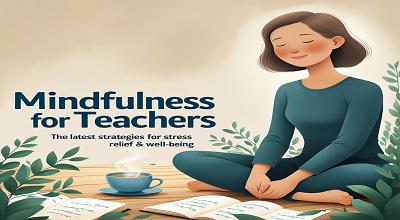Mindfulness for Teachers
Mindfulness for Teachers: Teaching is one of the most rewarding yet demanding professions. Educators juggle lesson planning, classroom management, student engagement, and administrative tasks daily. Over time, this can lead to burnout, stress, and emotional exhaustion.
Mindfulness—a practice rooted in being fully present and non-judgmentally aware—has emerged as a powerful tool for teachers to manage stress, improve focus, and enhance overall well-being. In this comprehensive guide, we explore the latest mindfulness techniques tailored for educators, backed by research and practical applications.
What is Mindfulness?
Definition and Origins
Mindfulness is the practice of paying attention to the present moment with openness, curiosity, and without judgment. It originates from Buddhist meditation traditions but has been secularized in modern psychology.
The Science Behind Mindfulness
Research shows that mindfulness:
- Reduces cortisol (the stress hormone)
- Increases gray matter in brain regions linked to emotional regulation
- Enhances focus and cognitive flexibility
Benefits for Teachers
- Lower stress levels – Helps manage classroom pressures
- Improved emotional regulation – Reduces reactive responses
- Enhanced focus – Better lesson delivery and student engagement
Why Teachers Need Mindfulness?
The Impact of Teacher Stress
Studies reveal that nearly 50% of teachers report high stress levels, leading to burnout and attrition. Chronic stress affects health, job performance, and student outcomes.
How Mindfulness Reduces Burnout?
Mindfulness helps by:
- Breaking the cycle of negative thoughts
- Encouraging self-compassion
- Promoting relaxation responses
Improved Classroom Environment
Teachers who practice mindfulness report:
- Better classroom management
- Increased empathy toward students
- More positive interactions
Latest Mindfulness Techniques for Teachers
Breathing Exercises for Instant Calm
Try the 4-7-8 technique:
- Inhale for 4 seconds
- Hold for 7 seconds
- Exhale for 8 seconds
Body Scan Meditation
A 5-minute practice to release tension:
- Sit or lie down comfortably
- Focus on each body part, from toes to head
- Notice sensations without judgment
Mindful Walking Between Classes
Instead of rushing, walk with awareness:
- Feel each step
- Notice surroundings
- Breathe deeply
Gratitude Journaling
Writing 3 things you’re grateful for daily shifts focus from stress to positivity.
Digital Detox for Mental Clarity
Set boundaries:
- No emails after work hours
- Screen-free breaks
Incorporating Mindfulness into Daily Teaching
Mindful Listening to Students
- Maintain eye contact
- Avoid interrupting
- Reflect before responding
Pausing Before Responding
A 3-second pause prevents reactive outbursts.
Creating a Calm Classroom Atmosphere
- Soft lighting
- Quiet corners for reflection
- Mindful breathing exercises with students
Mindfulness Apps and Resources for Teachers
Top Apps
- Headspace (Guided meditations)
- Calm (Sleep and relaxation)
- Insight Timer (Free mindfulness sessions)
Online Courses
- Mindful Schools (Mindfulness for educators)
- Coursera’s “De-Mystifying Mindfulness”
Recommended Books
- The Mindful Teacher by Shirley & MacDonald
- Teach, Breathe, Learn by Meena Srinivasan
Success Stories
1: Reducing Anxiety Before Class
A high school teacher used 5-minute breathing exercises before lectures, leading to less anxiety and clearer instruction.
2: Enhancing Patience with Students
An elementary teacher practiced mindful listening, resulting in fewer conflicts and better student relationships.
3: Better Work-Life Balance
A university professor adopted digital detoxing and reported improved sleep and family time.
Common Challenges and Solutions
“I Don’t Have Time for Mindfulness”
- Start with 1-minute exercises
- Integrate into existing routines
Dealing with Initial Resistance
- Begin with small steps
- Track benefits in a journal
Staying Consistent
- Set reminders
- Join a mindfulness group
The Future of Mindfulness in Education
- Teacher training programs now include mindfulness modules
- Schools are adopting mindfulness curriculums
- Research explores AI-driven mindfulness tools
Conclusion
Mindfulness is not just a trend—it’s a lifeline for teachers facing immense pressures. Educators can reduce stress, improve classroom dynamics, and enhance personal well-being by adopting simple techniques. Start small, stay consistent, and witness the transformation.
